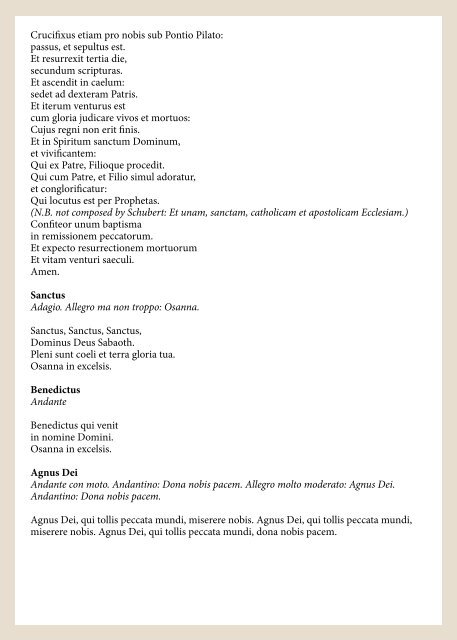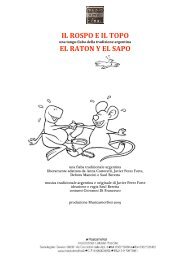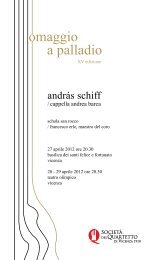ANDRÁS SCHIFF - Società del Quartetto di Vicenza
ANDRÁS SCHIFF - Società del Quartetto di Vicenza
ANDRÁS SCHIFF - Società del Quartetto di Vicenza
You also want an ePaper? Increase the reach of your titles
YUMPU automatically turns print PDFs into web optimized ePapers that Google loves.
Crucifixus etiam pro nobis sub Pontio Pilato:<br />
passus, et sepultus est.<br />
Et resurrexit tertia <strong>di</strong>e,<br />
secundum scripturas.<br />
Et ascen<strong>di</strong>t in caelum:<br />
sedet ad dexteram Patris.<br />
Et iterum venturus est<br />
cum gloria ju<strong>di</strong>care vivos et mortuos:<br />
Cujus regni non erit finis.<br />
Et in Spiritum sanctum Dominum,<br />
et vivificantem:<br />
Qui ex Patre, Filioque proce<strong>di</strong>t.<br />
Qui cum Patre, et Filio simul adoratur,<br />
et conglorificatur:<br />
Qui locutus est per Prophetas.<br />
(N.B. not composed by Schubert: Et unam, sanctam, catholicam et apostolicam Ecclesiam.)<br />
Confiteor unum baptisma<br />
in remissionem peccatorum.<br />
Et expecto resurrectionem mortuorum<br />
Et vitam venturi saeculi.<br />
Amen.<br />
Sanctus<br />
Adagio. Allegro ma non troppo: Osanna.<br />
Sanctus, Sanctus, Sanctus,<br />
Dominus Deus Sabaoth.<br />
Pleni sunt coeli et terra gloria tua.<br />
Osanna in excelsis.<br />
Bene<strong>di</strong>ctus<br />
Andante<br />
Bene<strong>di</strong>ctus qui venit<br />
in nomine Domini.<br />
Osanna in excelsis.<br />
Agnus Dei<br />
Andante con moto. Andantino: Dona nobis pacem. Allegro molto moderato: Agnus Dei.<br />
Andantino: Dona nobis pacem.<br />
Agnus Dei, qui tollis peccata mun<strong>di</strong>, miserere nobis. Agnus Dei, qui tollis peccata mun<strong>di</strong>,<br />
miserere nobis. Agnus Dei, qui tollis peccata mun<strong>di</strong>, dona nobis pacem.<br />
Even though he wasn’t a fervent believer, at least accor<strong>di</strong>ng to his biography, the catalogue of<br />
Schubert includes several sacred works: six latin Masses, one Mass and one Lutheran Requiem<br />
and other pieces; the seeming <strong>di</strong>screpancy results from the fact that sacred music was often<br />
commissioned and gave a source of profit for the musician. In particular, the composition<br />
of his Mass n° 6 was assigned him by his friend Leitermayer, master of the choir in Alsergrund,<br />
in 1828. This work is characterized by a symphonic breath, where choral parts are more<br />
important than sections written for solo voices. There are some similarities with Beethoven’s<br />
Missa Solemnis: following his example, Schubert uses expansive fugues and abundant counterpoints,<br />
but he <strong>di</strong>ffers from him in the wideness of melo<strong>di</strong>es, that are almost lyric, and in the<br />
modulations, which are freer and bolder than those used in classic harmony.<br />
It is very interesting to notice the sudden change into the minor mode at Crucifixus, or the<br />
imposing entry of the Sanctus, in which the juxtaposition of <strong>di</strong>stant chords generates a resonance<br />
that gives us the impression of seeing an afterworld.<br />
Beethoven’s death determined a very important transformation in the musical scene in Vienna:<br />
in fact on the one hand, the lea<strong>di</strong>ng reference figure was lost, on the other younger musicians<br />
had the possibility to emerge from the shadow of the Maestro, asserting their personality<br />
and becoming well known to the au<strong>di</strong>ence.<br />
That’s why in 1828 Schubert completely devoted himself to composition, achieving significant<br />
goals that are, at last, entirely romantic: we remember above all his last sonatas for piano, his<br />
Mass in E-flat and other works, among which his last String Quintet, D 956. The three sonatas<br />
D 958 – D 960 actually form a group, <strong>di</strong>stinguished by common formal elements, such as the<br />
<strong>di</strong>vision and the structure of the four movements, and by an overall stylistic connection which<br />
enhances a close and deep feeling.<br />
The sonata in B-flat major perfectly shows these characteristics: Schubert can’t forget Beethoven’s<br />
teaching, but goes beyond those features, determining a personal language, which starts from time<br />
expansion and produces a more fluent and less dramatic tone and a less consistent progress: it is<br />
the so-called “<strong>di</strong>vine length” (Schumann), that his contemporaries <strong>di</strong>dn’t always understand.<br />
“In Beethoven’s music we never lose our bearings, we always know where we are; Schubert, on<br />
the other hand, puts us into a dream”: a <strong>di</strong>fference stressed by Alfred Bren<strong>del</strong> who, developing<br />
his thought, justifies the parallel he drew between Schubert and Mahler.<br />
Schubert surpassed his master, but he <strong>di</strong>dn’t reject him: the beginning of the Molto moderato<br />
derives from the Trio op. 97 by Beethoven and the theme of the last movement is taken from<br />
the last part of the Quartet op.130; this two references show that Schubert absorbed and understood<br />
the prece<strong>di</strong>ng pattern and then he was able to evolve it.<br />
Andrea Scarpari




